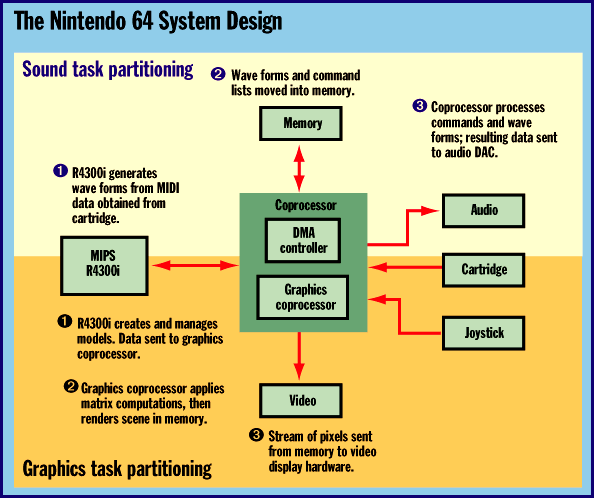The second component
of interest is the custom chip - the Reality Co-Processor (RCP). This
is a 62.5Mhz chip that interfaces directly to the CPU. The RCP is
designed to handle most of the audio and graphics processing. In addition
to this, the chip also contains DMA logic, audio and video outputs,
and a joystick input. The chip also supports timing and signals for
the game cartridges.
There
are two processors inside the RCP:
*
RSP: Short for Reality Signal Processor. The RSP performs all
3D manipulations and audio functions. A special feature is that this
processor is configurable via microcode allowing the system to be
optimised over time.
*
RDP: Reality Drawing Processor. A pixel drawing processor.
This unit performs all pixel-level operations including texture mapping,
anti-aliasing, tri-linear interpolation, MIP mapping and z-buffering.The
RDP operates on a display list to provide it's graphics output meaning
the RDP is essentially an Object List Processor.
SGI
claim that the RCP contains a vector processor (probably the RSP)
that can perform over half a billion arithmetic operations per second
- approximately 10 times the raw compute power of a lowend Pentium.
Internally the RCP performs 128bit processing, although this could
be "split" between the RSP and RDP.
The audio is generated
by both the R4300i and the RCP, presumably using the CPU to provide
the music data, while the RCP performs the actual sound generation.
It is possible to produce 16bit stereo sound at up to 48Khz (greater
than CD at 44.1Khz). The number of sound channels is not defined
in hardware. The total number of simultaneous voices depends on the
software although 64 channels is apparently possible.
The process of designing
the RCP took six supercomputers running simulations for 24 hours that
took seven days to complete. The result is a processor smaller than
a fingernail.

